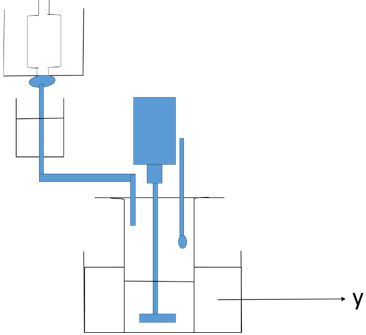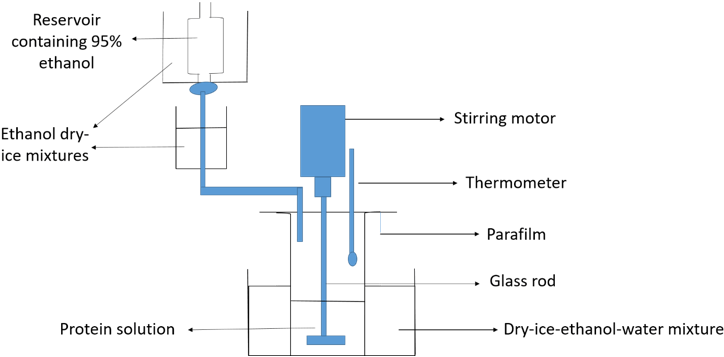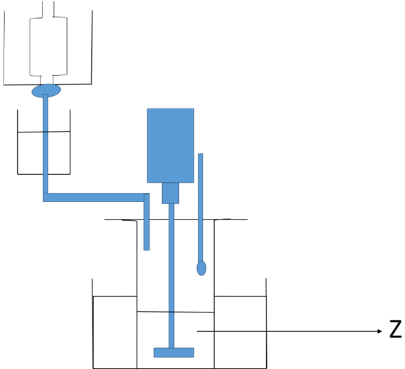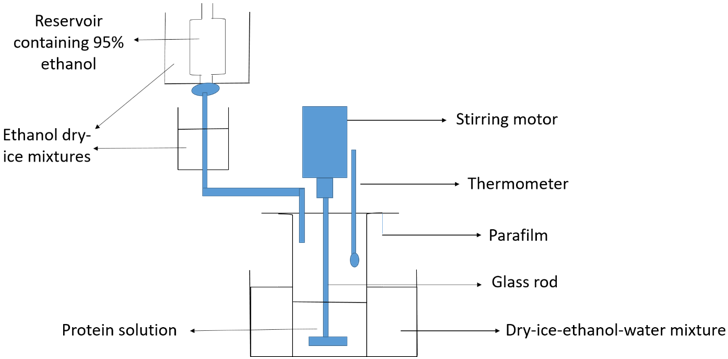This set of Enzyme Technology Multiple Choice Questions & Answers (MCQs) focuses on “Enzymes Purification – Organic Solvent Fractionation”.
1. Which of the following is not a step involved in purification?
a) Precipitation
b) Dialysis or ultrafiltration
c) Chromatographic techniques
d) Freezing technique
View Answer
Explanation: Freezing technique is a method wherein the cells are subjected to cold temperatures of about -15°C to -20°C. This is nothing but a cold or psychrophilic shock. It is a physical method for extraction of enzymes. Purification involves the following steps: precipitation, dialysis or ultrafiltration, chromatographic techniques and purity checking by chromatography or spectrophotometry.
2. Insulin is purified under ___________ purifications.
a) analytical
b) chromatography
c) preparative
d) ultrafiltration
View Answer
Explanation: Purification is classified into preparative or analytical. Preparative purification is targeted towards producing large quantities of purified proteins which are of commercial important. Examples which are purified by the preparative technique are laccase, insulin, HbS Ag, etc. Analytical purification is used to produce small scale lab production of purified proteins. Ultrafiltration and chromatography are the steps involved in purification.
3. Purifications of purified proteins involved in small scale lab productions meant mainly for research purposes are referred to as _____________
a) preparative purifications
b) chromatographic techniques
c) analytical purifications
d) dialysis techniques
View Answer
Explanation: The two main classification of purifications are preparative and analytical. Analytical purification are involved in small scale lab preparations and mainly used for research purposes. Examples purified by analytical purifications are as follows: pronase, dispase, caspase etc. Preparative purifications involve large scale productions of commercial important proteins. Chromatography and dialysis techniques are the steps involved in purification.
4. His-Tag allows the purification to be done in fewer steps.
a) True
b) False
View Answer
Explanation: If the interested protein is low in abundance or have high value, recombinant DNA technology may be used. This will lead to large production of desired protein. This technology allows the protein to be tagged with certain molecular marker which allows the purification to be done in fewer steps. One such marker is His-Tag.
5. Which of the following is a disadvantage of organic solvent fractionation?
a) Faster than column techniques
b) Denaturation of proteins
c) Low density than salt solutions
d) Short centrifugation times
View Answer
Explanation: The major disadvantage of organic solvent fractionation is denaturation proteins due to use of organic solvent. Advantages are faster run time when compared to other column techniques. When compared to ammonium sulphate precipitation, it offer lower density to salt solutions and short centrifugation times to collect the precipitated enzyme.
6. A preferable technique to perform fractionation is to cool the enzyme solution.
a) True
b) False
View Answer
Explanation: To avoid denaturation due to use of organic solvent, low temperatures need to be maintained. This can be done by using cold rooms at low fixed temperatures. But still it is difficult to maintain the enzyme at low temperatures during fractionation. Hence a preferred technique is to cool the enzyme solution. This can be done by either mechanically refrigerated bath or ice bath containing dry ice – ethanol-water mixture.
7. What is the next step after organic solvent fractionation with dry ice – ethanol – water mixture?
a) Refrigerated centrifugation at 3000 g for 15 mins
b) Drying in freezer
c) Supernatant fractionation with ethanol
d) Precipitated protein dissolved in 0.01 to 0.05 M cold buffer
View Answer
Explanation: In organic solvent fractionation, the desired protein to be purified is kept a bath containing dry ice – ethanol -water mixture. Constantly ethanol is added which increases temperature of the solution. While adding the ethanol the protein solution is stirred continuously and also after all the ethanol is added for 15 mins. Then the solution is centrifuged in refrigerated centrifugation at 3000 g for 15 mins. The resultant supernatant is fractionated with ethanol, followed by drying in freezer keeping the tubes in inverted position. The last step is to dissolve the precipitated protein with 0.01 to 0.05 M cold buffer. Hence the first step after organic solvent fractionation is refrigerated centrifugation at 3000 g for 15 mins.
8. In the below diagram of organic solvent fractionation, what does Y represent?

a) Stirring motor
b) Thermometer
c) Protein solution
d) Dry-ice-ethanol water mixture
View Answer
Explanation: The above diagram represents the apparatus for organic solvent fractionation. Organic solvent fractionation utilizes dry ice-ethanol-water mixture for purification if desired protein. With constant addition of ethanol temperature is maintained as required. The apparatus below shows that Y represent dry-ice-ethanol-water mixture.

Hence Y represents dry-ice-ethanol-water mixture.
9. What does Z represent in the following diagram?

a) Parafilm
b) Glass rod
c) Protein solution
d) Ethanol-dry ice mixture
View Answer
Explanation: The diagram represents the apparatus for organic solvent fractionation using ethanol.

Z in the diagram represents the protein or enzyme solution which is to be purified. Parafilm is placed on the top of the beaker containing protein solution to avoid splashing of the cooling bath contents into the beaker. Glass rod along with motor is added to the beaker containing protein solution for proper mixing. Ethanol-dry ice mixture is used to maintain the temperature of the solvent.
10. Ethanol can be removed from protein precipitate by __________
a) lyophilization
b) ultrasonication
c) homogenization
d) dialysis
View Answer
Explanation: Ultrasonication and homogenization are the physical methods used to extract enzymes from cells. Dialysis is a step involved in purification. Whereas lyophilization can be used to remove ethanol traces from protein precipitate. Another way is to keep the tubes in an inverted position in a deep freezer for a few minutes to allow extra ethanol to drain and then wipe off the extra traces by tissue paper.
Sanfoundry Global Education & Learning Series – Enzyme Technology.
To practice all areas of Enzyme Technology, here is complete set of 1000+ Multiple Choice Questions and Answers.
If you find a mistake in question / option / answer, kindly take a screenshot and email to [email protected]
- Practice Chemical Engineering MCQs
- Check Chemical Engineering Books
- Apply for Biotechnology Internship
- Apply for Chemical Engineering Internship
- Check Enzyme Technology Books
